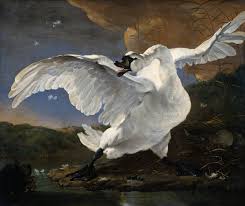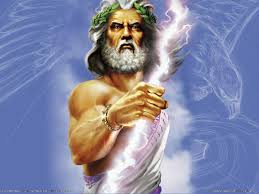 Swans are in the fields of Holland... all over the country, big white birds nestled into the pastures, along side the sheep, even.
Swans are in the fields of Holland... all over the country, big white birds nestled into the pastures, along side the sheep, even.I'm thinking today of the Easter Swan.

I'm of course talking about Zeus. The same guy who was known to say,
Release the Kraken!
 from time to time. from time to time. |
Hm... the first Sunday following the full moon? At its roots, at least, are some pagan associations. Also involves bunnies, for some reason, the rabbit most associated with fertility, because of its, well, fertility...

What with being surrounded by swans here in the beautiful country of Holland, on this auspicious and complicated (and fertile) day, celebrated by more than one religious observance, all of which I'd like to pay due respect to, and mean in no way to denigrate - it just makes sense somehow that I should think of Zeus as the Easter Swan.
It's complicated, though. Namely, because,
Seriously, he stood a better chance seducing Leda disguised as a swan, rather than an attractive and super-cut god?
Wow. Well, any diety that can turn itself into a bird and STILL manage to seduce that hottest girl in all of Greece - and procreate a set of twins in the process - well, that beats a rabbit as my Easter mascot.







Here's your answer.
ReplyDeletehttp://www.beyond-the-pale.co.uk/leda.htm
Hey Krista,
ReplyDeleteI liked your use of "the threatened swan" by Jan Asselijn (bigger version: http://www.rijksmuseum.nl/images/aria/sk/z/sk-a-4.z ). It's a painting steeped in Dutch history. Nothing to do with Easter, as far as I know, but this swan is a man too: it's an allegorical picture referring to Johan de Witt, Grand Pensionary of the States of Holland. Here he's shown protecting Dutch liberties (the eggs) against external enemies (the dog), most notably England.
He was an opponent of stadtholder William II, who tried to establish the dynasty of Orange as hereditary souvereigns, introducing several laws to keep William's son, Fredrick Henry, from inheriting the position of stadtholder.
He paid the price for his machinations when his attempt at diplomacy with the French backfired. The Orangists (supporters of Fredrick Henry's son William III) blaimed De Witt for the Dutch War of 1672.
Johan de Witt and his brother Cornelis, a naval officer who had played an important role in the raid on the Medway in 1667, were murdered by an Orangist mod. William III was made stadtholder, and he attempted to negotiate an alliance with the English against teh French. This didn't work, but a few years later the English wanted to get rid of their king James II because he was a Catholic. William saw an opportunity and put himself forward as the figurehead of the Glorious Revolution of 1688.
In 1689 William III was crowned king of England. He finially managed to obtain a hereditary title that came with some real power. The hereditary part didn't do him any good, though, as he died childless in 1702.
The painting of the swan represents the most powerful man of the most powerful nation of the day, akin to the POTUS nowadays. Between 1672 and 1702 England took over the position of most powerful nation in the world.
Here's a picture of the swan and his brother after they were butchered. It's quite disturbing.
http://www.rijksmuseum.nl/images/aria/sk/z/sk-a-15.z
See you on your next Dutch tour! Love,
Jaap
P.S.: Remon says "hi" too!